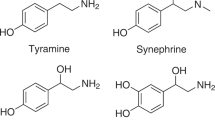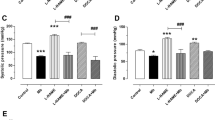Abstract
IT has been suggested1 that one of the biological roles of substances having so-called ‘vitamin P' action is their ability to protect epinephrine (or syrnpathin) from destruction in the body by combining with copper. This is believed to result in enhanced tone and diminished permeability of the capillaries, with a subsequent amelioration of the hæmorrhagic diatheses for which ‘vitamin P' has been claimed to be effective2. Many substances, ranging from such simple ones as catechol and pyrogallol3 to complex glycosides such as rutin1'4, have been reported as potentiating epinephrinemediated effects on isolated organs and in intact animals. An examination of the structure of those substances which have been reported to be effective in decreasing capillary fragility or permeability suggests that there may be no common mechanism of action of these substances.
This is a preview of subscription content, access via your institution
Access options
Subscribe to this journal
Receive 51 print issues and online access
$199.00 per year
only $3.90 per issue
Buy this article
- Purchase on Springer Link
- Instant access to full article PDF
Prices may be subject to local taxes which are calculated during checkout
Similar content being viewed by others
References
Javillier, M., and Lavollay, J., Helv. Chim. Acta, 29, 1283 (1946). Parrot, J., Gaz. Med., 53, 157 (1946). Géro, E., Bull. Soc. Sci. Hyg. Aliment., 34, 85 (1946).
Parrot, J., and Galmiche, P., Bull. Med., 59, 413 (1945). Galmiche, P., "La résistance et la perméabilité des vaisseaux capillaires et la vitamine P" (Librarie le François, Paris, 1945). Muset, P. P., "Introducion al éstudio de la vitamina P" (Miguel Servet, Barcelona, 1945). Munro, H. N., Lazarus, S., and Bell, G. H., Nut Abst. and Rev., 17, 291 (1947).
Bacq, Z. M., Arch. Internal. Physiol., 42, 340 (1936) and 44, 15 (1936). Clark, A. J., and Raventos, J., Quart. J. Exp. Physiol. 29, 185 (1939).
Wilson, R. H., Mortarotti, T. G., and De Eds, F., J. Pharm. Exp. Therap., 90, 120 (1947).
Friedenwald, J. S., and Buschke, W., Amer. J. Physiol., 140, 367 (1943).
Mager, A., Z. physiol. Chem., 274, 109 (1942).
Lavollay, J., C.R. Soc. Biol., 135, 1193 (1941).
Lavollay, J., "I. L‘autoxydation des diphénols, en particulier de l‘adrenaline. II. Structure et role fonctionnel de la vitamine P" (Hermann et Cie., Paris, 1943).
Bartlett, G. R., Fed. Proc., 7, 6 (1948); J. Pharm. Exp. Therap. 93, 329 (1948).
Huggins, C., Jensen, E. V., and Cleveland, A. S., Proc. Soc. Exp. Biol. and Med., 68, 477 (1948).
Geissman, R. A., and Friess, S. L. (unpublished work).
Author information
Authors and Affiliations
Rights and permissions
About this article
Cite this article
CLARK, W., GEISSMAN, T. Potentiation of Epinephrine Effects by Flavonoid Compounds. Nature 163, 36–37 (1949). https://doi.org/10.1038/163036a0
Issue Date:
DOI: https://doi.org/10.1038/163036a0
Comments
By submitting a comment you agree to abide by our Terms and Community Guidelines. If you find something abusive or that does not comply with our terms or guidelines please flag it as inappropriate.



